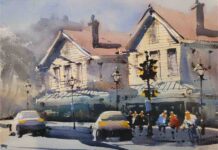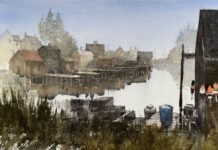
“Necessity and curiosity brought me outside to paint about 15 years ago and, try as I might, I have not been able to shake this particular habit,” says Iain Stewart. “My go-to setup is for sketching, which I liken to a broad offensive, allowing me to tackle more subjects in any given day and move on. Still, the easel calls, and when it does, I listen. I’m not a fan of labels. In the purest sense I’m an artist, and I try to capture the essence of a place or the way a certain location makes me feel.
“In the last few months, as weather permits, I’ve been repeating a practice I’ve enjoyed for at least a decade, typically during the false spring of the south. I pack up my gear and drive the back roads near my home looking for subjects. As with anything repetitive, one becomes accustomed to a particular exercise. For me, that’s drawing from life. Photographs become a little lifeless over the rainy winter months, and my on-site sketches more energetic and palpable as possible subjects. I believe that’s because painting from life allows you to take more liberty in your decision-making, and being in the place you are attempting to capture is much more personal than looking at a screen. Equally as important, I’m painting where I grew up, near Auburn University in Alabama.”
The Stories Behind the Paintings
The Train at 6th Street (Opelika, AL)

“Trains are a constant in the South. They connect me to my childhood in the same way diesel fuel and seaweed connect me to Scotland. There’s a scent, a sound, a pulse of a train as it moves through your city. In Auburn we lived two blocks from the tracks, and the train would wake us up until we learned to allow it to lull us to sleep. It also woke a family of peacocks the neighbors kept, so there was this odd mix of cawing and the train’s horn piercing the usual quiet that somehow fit.”
Walking Chewcala Creek (Auburn, AL)

“There was a main entrance to Chewacla State Park and a sneak route called Po’ Man’s because you didn’t have to pay; my friends and I always took the latter. I imagined the lighting for this scene depicting a last-of-the-day walk down the creek before heading home. As I painted, I recalled countless hikes up the hill, wearing soggy Vans and grins on our faces, chatting about whatever was on our minds and taking in the last gasp of spring before summer set in.”
2nd Avenue Bridge (Opelika, AL)

“To be clear, there’s no way I would ever try to sketch this scene on site. With only a small curb separating me from the heavy traffic of Opelika Road and a 30-foot fall to the tracks below, I had to work quickly to test the spot for shadows and time of day before I could get a good reference photo. Our mayor designated the downtown area a historic district in the ’90s, so it hasn’t changed much, with the exception of the bridge I was standing on to get this shot and the bridge in the foreground. Fun fact: Opelika was known for its rather sporting populace, and rather than slow down, passing trains sped up as the clientele of local saloons and houses of ill repute took pot shots at them as they went by.”
Iain Stewart enjoys the freedom he feels painting in his sketchbook so much that he decided to take it to a higher level, asking, “What if you could work on a studio painting using this same method and mindset?” He shares his process in Iain Stewart: High Level Sketching.







